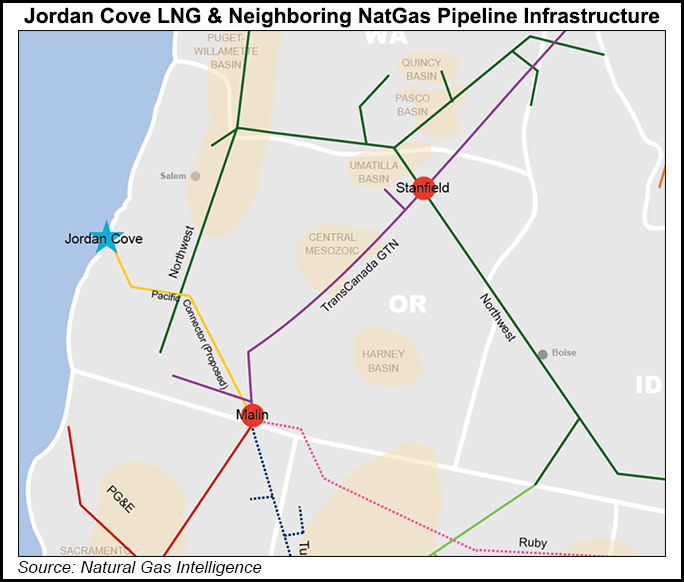Regulatory | LNG | LNG Insight | NGI All News Access | NGI The Weekly Gas Market Report
Jordan Cove LNG Finally Approved by FERC on Split Vote
FERC on Thursday authorized the Jordan Cove liquefied natural gas (LNG) project after weeks of delay, leaving sponsors to untangle remaining state-level roadblocks in Oregon.

Commissioners voted 2-1, with Chairman Neil Chatterjee and Bernard McNamee in favor and Richard Glick voting against, to authorize the siting, construction and operation of Jordan Cove and the associated Pacific Connector gas pipeline project in Coos County, OR [CP17-494, CP17-495].
The Federal Energy Regulatory Commission had been scheduled to vote on the same motion last month but set it aside a day after Oregon’s Department of Land Conservation and Development (DLCD) concluded that the project was not consistent with the state’s Coastal Management Program. As a result, FERC and the Army Corps of Engineers “cannot grant any license or permit to this project unless this objection is overridden on appeal by the U.S. Secretary of Commerce,” DLCD said in a 2,251-page FERC filing.
Commissioners who voted for Thursday’s motion disputed the DLCD’s conclusion.
“I look at the record before me for each certificate when making a decision, and I felt that the record in this proceeding justified approving the project,” Chatterjee said. “Certainly we are cognizant of the issues at the state level, but we have to process the applications that are submitted to us, and in this instance a majority of the Commission found that this was a lawfully submitted application and voted to approve it.”
“As in other cases, I have carefully considered the facts, record and law,” McNamee said. “The views of the State of Oregon are particularly important and I have considered Oregon DLCD’s letter. As discussed in the order, the issues raised were already considered in the Commission’s environmental impact statement or are specifically addressed in the order.”
However, as he has on several recent occasions, Glick opposed the FERC majority, based on environmental concerns.
“I believe today’s decision plainly violates the requirements of both the National Gas Act and the National Environmental Policy Act in order to achieve an outcome-oriented desire to approve the projects,” Glick said. “As is the norm these days, this order fails to consider the impact the projects’ greenhouse gas emissions will have on climate change.”
Oregon has also denied the project a water quality certificate and a dredging permit.
The project, to be capable of liquefying up to 1.04 Bcf/d for export, would include a pipeline gas conditioning facility, five liquefaction trains, two full-containment LNG storage tanks and associated equipment, an LNG loading platform and transfer line, marine facilities, and associated facilities [CP17-494, CP17-495]. As proposed, the LNG terminal would handle about 120 LNG carriers per year.
The project, which has cleared several regulatory hurdles, has faced fierce opposition from environmental groups since it was proposed by Veresen Inc., now part of Pembina Pipeline Corp. FERC rejected an application for the project in March 2016, citing problems with its Pacific Connector pipeline link to tap Western Canada and U.S. Rockies supplies, along with a lack of contracts from buyers. The application was refiled in September 2017. FERC staff issued a final environmental impact statement for Jordan Cove and the Pacific Connector gas pipeline project in November.
The pipeline would originate at interconnections with existing pipeline systems in Klamath County, OR, and span parts of the Oregon’s Klamath, Jackson, Douglas, and Coos counties before connecting with the terminal. The nearly 229-mile, 36-inch-diameter pipeline would be capable of transporting up to 1.2 Bcf/d.
Jordan Cove would be the first natural gas export facility sited on the U.S. West Coast.
© 2024 Natural Gas Intelligence. All rights reserved.
ISSN © 1532-1231 | ISSN © 2577-9877 | ISSN © 1532-1266 |
